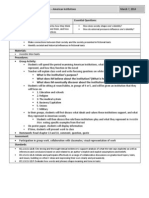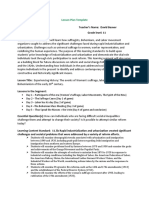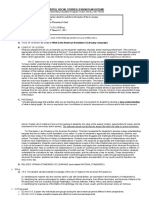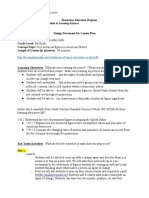Activism Lesson I
Uploaded by
api-356518929Activism Lesson I
Uploaded by
api-356518929What Is Activism?
Tyler M. Banks
Standards/Quality Indicators/Skills
Missouri and national standards, quality indicators, and skills addressed by this lesson
Missouri State Standards (English/Language Arts)
1. Collaborative Discussions 6-12 Correlation Speaking/Listening 1A, 1C: Speak effectively in
collaborative discussions
2. Fiction 6-12 Correlation Reading Literary 1A: Develop and apply skills and strategies to
comprehend, analyze, and evaluate fiction, poetry, and drama from a variety of cultures and
times
National Standards
1. READING FOR PERSPECTIVE: Students read a wide range of print and nonprint texts to build an
understanding of texts, of themselves, and of the cultures of the United States and the world; to
acquire new information; to respond to the needs and demands of society and the workplace; and
for personal fulfillment. Among these texts are fiction and nonfiction, classic and contemporary
works.
Learning Objectives/Goals
The lessons objectives and learning outcomes appropriate for meeting curricular and student needs
Students will:
Students will participate as knowledgeable, reflective, creative, and critical members of whole-
and small-group activities
Students will determine what is through reflecting upon information presented within the book
Brave Girl: Clara and the Shirtwaist Makers Strike of 1909.
Students will begin to determine and identify qualities at which an activist possesses
Resources and Materials
List of materials used in the planning of and during the instruction of the lesson
1. Brave Girl: Clara and the Shirtwaist Makers Strike of 1909
2. White Board
What Is Activism?
Tyler M. Banks
Lesson Structure and Procedures
Sequence of events of the lesson elements. (The before, during, and after the lesson, e.g. Engagement/Opening,
Procedures, Guided Practice, Conclusion
Part I: Teaching Point
I will begin by students with the question of What is an activist? As to assess what they already know, students
will have an opportunity to raise their hands and offer explanations to the provided question.
1. Following the small discussion I will begin by introducing a picture book biography titled Brave
Girl: Clara and the Shirtwaist Makers Strike of 1909, the story that details the plight of
immigrants in America in the early 1900s and the timeless fight for equality and justice by a
young Ukrainian immigrant activist named Clara, by Michelle Markel.
2. After the read aloud we will refer back to our original question. We will discuss how Claras
need to fight for what was right and what she believed in made her an activist.
3. Prior to moving on we will, as a class, create a concise definition of what an activist is.
Activist:
activist /aktivst/
noun
A person who campaigns to bring about political or social change.
Part II : Active Engagement
1. Students will be broken up into three or four small groups, depending on the class size to discuss the
question that they were posed with.
2. In their groups, students will begin by answering the following in their Notebooks: What makes someone
an activist in a community?
3. After the small-group discussions students will be asked to share their group responses with the class. As
students are sharing I will chart their responses until I come up with a list of list of qualities that an
activist has. Students will be encouraged to share examples of people in their families, neighborhoods,
schools, faith-based organizations or other communities that exemplify these traits.
4. After we have discussed qualities of activist students will be presented with the closing question of, Do
you guy have some of these qualities?, Can students be activist?
You might also like
- Native American Unit Within The Multicultural Literature Class100% (1)Native American Unit Within The Multicultural Literature Class13 pages
- Self-Learning Module For Grade 11: Chapter Iv: Estimation of ParametersNo ratings yetSelf-Learning Module For Grade 11: Chapter Iv: Estimation of Parameters88 pages
- Social Studies Lesson Plan Template: Rationale For InstructionNo ratings yetSocial Studies Lesson Plan Template: Rationale For Instruction6 pages
- Lesson Title: Painting The Picture: Ccss - Ela-Literacy - Ri.3.7No ratings yetLesson Title: Painting The Picture: Ccss - Ela-Literacy - Ri.3.76 pages
- Schwartz Lauren Term IV Final Social Action Project 10-Day PlanNo ratings yetSchwartz Lauren Term IV Final Social Action Project 10-Day Plan45 pages
- Instructional Strategies - Social StudiesNo ratings yetInstructional Strategies - Social Studies4 pages
- Lesson Plan: The Story of An Hour, and Be Prompted ToNo ratings yetLesson Plan: The Story of An Hour, and Be Prompted To8 pages
- Powerful Social Studies Lesson Plan OutlineNo ratings yetPowerful Social Studies Lesson Plan Outline10 pages
- Curriculum Planning Chart - Educational (In) Equality? - Anthony J. ZarateNo ratings yetCurriculum Planning Chart - Educational (In) Equality? - Anthony J. Zarate6 pages
- Curriculum Planning Chart - Educational (In) Equality? - Anthony J. ZarateNo ratings yetCurriculum Planning Chart - Educational (In) Equality? - Anthony J. Zarate5 pages
- Lesson Plan Date: - Grade: Concept: ObjectivesNo ratings yetLesson Plan Date: - Grade: Concept: Objectives3 pages
- Cooperative Problem-Solving Activities for Social Studies Grades 6–12From EverandCooperative Problem-Solving Activities for Social Studies Grades 6–12No ratings yet
- Argumentative Essay - Extra-Curricular ActivitiesNo ratings yetArgumentative Essay - Extra-Curricular Activities1 page
- Pengembangan PCK (Pedagogical Content Knowledge) Mahasiswa Calon Guru Biologi Fkip Universitas Muhammadiyah Surakarta Melalui Simulasi PembelajaranNo ratings yetPengembangan PCK (Pedagogical Content Knowledge) Mahasiswa Calon Guru Biologi Fkip Universitas Muhammadiyah Surakarta Melalui Simulasi Pembelajaran15 pages
- Majid Majeed Akbar: Objective: Professional ExperienceNo ratings yetMajid Majeed Akbar: Objective: Professional Experience5 pages
- ENGLISH STD 9 II SEMESTER ASSINGMENTS AND ORAL EXAMINATIONNo ratings yetENGLISH STD 9 II SEMESTER ASSINGMENTS AND ORAL EXAMINATION3 pages
- Guideline For Final Year B.E. Project & PMMS Activities: (Semester VII and VIII)No ratings yetGuideline For Final Year B.E. Project & PMMS Activities: (Semester VII and VIII)71 pages
- Rwandan Teacher Education Program Action PlanNo ratings yetRwandan Teacher Education Program Action Plan5 pages
- Alba - Mary Jeanina - Reflection Paper #2No ratings yetAlba - Mary Jeanina - Reflection Paper #22 pages
- W WS SM MA A: Event 4111 - Trumpet SoloNo ratings yetW WS SM MA A: Event 4111 - Trumpet Solo34 pages
- Certificate Achievement: Sample Learner 120 Hour Advanced TEFL CourseNo ratings yetCertificate Achievement: Sample Learner 120 Hour Advanced TEFL Course1 page
- Full Download of Test Bank For Child and Adolescent Development in Context, 1st Edition Tara L. Kuther in PDF DOCX Format100% (3)Full Download of Test Bank For Child and Adolescent Development in Context, 1st Edition Tara L. Kuther in PDF DOCX Format37 pages

























































































